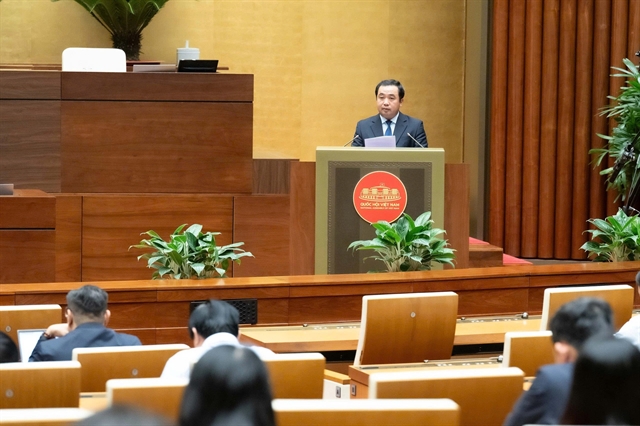 Economy
Economy

 |
| A panel discussion at the Green Finance for Wood and Furniture Industry dialogue held in HCM City on March 7. — VNA/VNS Photo |
HCM CITY — Việt Nam has 14 million hectares of forests, which, if well-managed, offer opportunities for the country to capitalise on the carbon credit market, a dialogue heard in HCM City.
Speaking at the Green Finance for Wood and Furniture Industry dialogue on the sidelines of HawaExpo being held in HCM City from March 6 to 9, Phùng Quốc Mẫn, deputy chairman of the Handicraft and Wood Industry Association of HCM City, said: “In the event that many countries around the world, including Việt Nam, are making efforts to achieve the Net Zero goal, meaning reducing carbon emissions has become a requirement for manufacturing industries.”
The Government has a series of specific action programmes, including a roadmap to develop the carbon credit market until 2028, he said.
While many other manufacturing industries consider reducing emissions as a challenge, the wood industry sees it as an opportunity since it possesses large planted forests where carbon credits are created, he said.
“If we know how to effectively exploit this source of carbon credits, the wood industry will not only contribute to the Net Zero goal but also increase economic efficiency from green finance for forest growers.”
Associate Professor Dr Nguyễn Đình Thọ, director of the Institute of Strategy and Policy on Natural Resources and Environment, said being one of the world’s largest wood and forestry producing countries, Việt Nam has policies for developing the forestry industry in a sustainable manner, including green finance and the carbon market, which would help minimise the impacts of climate change and address environmental challenges.
“Timber plays a role in absorbing and storing carbon, and is one of the few industries that produces negative greenhouse gas emissions compared to other industries with the same uses such as stone and plastics, and so wood can be used as a substitute for other high-emitting materials such as concrete, plastic and metal in the construction industry.”
Vũ Tấn Phương, director of the Vietnam Forest Certification Office, said 2023 marked a significant milestone for the forestry sector with Việt Nam signing agreements to sell 10.3 million forest carbon credits (10.3 million tonnes of CO2) for the first time through the World Bank for US$51.5 million.
The country received the first payment of $41.2 million last year and handed it to six north-central provinces, Nghệ An, Quảng Bình, Thanh Hóa, Hà Tĩnh, Thừa Thiên-Huế, and Quảng Trị to make payments to forest owners.
Nguyễn Ngọc Tùng, director of VinaCarbon Climate Impact Fund (a private investment fund that invests in companies and projects that can create carbon credits), also highlighted the wood industry’s huge potential to create carbon credits.
The longer a tree's lifespan, the more revenues a company could get from carbon credits, he said.
Other experts said reducing emissions requires the wood industry to comply with international regulations on sustainable forest management and exploitation, which would also increase their competitiveness and ability to penetrate large markets.
But to create carbon credits, businesses must integrate environmental, social and government (ESG) practices into their operations and report green house gas emissions, they said.
There are obstacles that make investors hoping to invest in Việt Nam's forest carbon credits cautious, while there are no specific instructions on how to collect and sell carbon credits, they pointed out.
For businesses to participate in sustainable forest management, certified materials mechanisms and policies need to be improved, they said.
They need to focus on financial and investment incentives for businesses adopting green production and making goods that do not cause deforestation, promote consumption of certified timber and wood products, and ensure fairness in the production and consumption of certified timber and wood products, they said.
It is also necessary to support capacity building by stakeholders implementing sustainable forest management and greenhouse gas emission reduction activities, they added. — VNS




